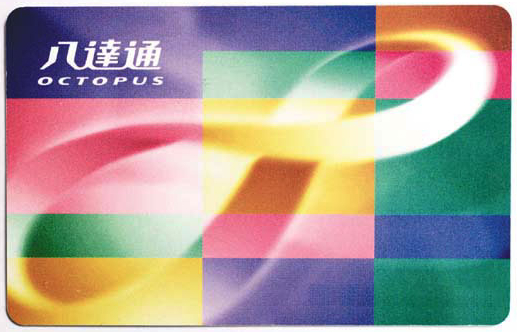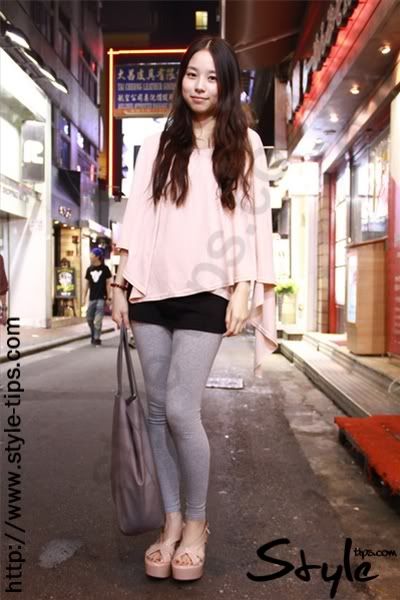Trains, Planes and Automobiles
Let's start off with getting around. Transportation is something that HK does extremely well; best airport for ease of use and efficiency (never a line at security or passport control!), a fast, clean and cheap subway system, an abundance of double decker bus lines, mini-buses galore, ferry lines, and a cheap taxi always within sight. The most useful thing for you to have always on you at all times is the Octopus Card:

You beep this card to pay for every kind of transportation (except taxis), but you can also use it all over town to pay for food at restaurants, coffee shops, convenience stores, etc. It's also how we get into our apartment building. We've got your cards all loaded up and ready for you to use. Don't leave home without it.
It's also good to know that due to the British colonization of HK up until 1997 they drive on the left side of the road, so watch out when crossing the street, but on the busiest roads they have painted on reminders of which way to look first to watch for cars. When walking around town, the sidewalks and train stations can be crowded and people don't care as much about personal space. You'll get jostled or cut in front of, or almost have head-on collisions, don't even try to walk more than two people abreast. Don't stand on the left side of the escalator (that's for people who want to walk up or down) or moving walkways. Be assertive, move ahead, take that subway seat fast, don't worry if you bump into somebody, no one is going to leave a gap for you or wait for you to go first. They don't do it to be rude, and they won't think you're rude. It's just how it goes in a densely populated city.
HK people are in a hurry (except I always manage to find slow pokes to walk behind so maybe I'm the one in a hurry) and you may not know it, but this is the most important button in the elevator:

If you are closest to the buttons in the elevator, it is your job to hit this button as soon as possible when someone gets off in order to shave off that half second of time to keep the elevator moving faster. We've gotten so accustomed to this, that now we do it every time and so do the kids.
Lost in Translation
What about the language? Sure, knowing Cantonese would be useful, but thanks to the British invasion, English is widely used. HK prides itself on being an international city and most people are bi-lingual or tri-lingual; it's actually quite humbling. In the main areas of the city you'll see signs, menus, pretty much everything in both Chinese and English. We haven't learned a large amount of Chinese because of this. The kids both learn Chinese at school, but they are learning Mandarin (spoken in mainland China) and HK-ers speak Cantonese, so that doesn't help us much either. The most useful word for you to know is mm-goy (this is my phonetic spelling, nothing official). It's an all purpose thank you, please, excuse me kind of phrase. Also useful is jo-sahn, means good morning.
Let's Eat!
On to eating, yum. While you can find every kind of cuisine here, of course we'll take you out for some delicious Chinese food. At a Chinese restaurant here, this is the typical place setting:

There's tea and hot water, but no big glass of ice water. The tea has the tea leaves freely floating in the tea pot so the tea in your cup will be chunky style, but the leaves settle to the bottom just fine. Much of the time water served at restaurants (Chinese or otherwise) is hot or warm water, occasionally it'll be cold. We've been told it's because cold water disrupts digestion, cold water makes women gain weight, cold water hurts people's teeth, and warm/hot water means the water has been boiled (so safe to drink). As a side note, the water here is totally safe to drink and we've been drinking it out of the tap for the past year, but my team at work gasped when I told them this and think we're crazy.
Of course there are chopsticks, but don't sweat it, every restaurant that we'll take you to does have forks upon request. Meals are served family style, rarely does each diner order their own entrée (in Chinese restaurants anyway). Unlike home, most people don't use the plate (which isn't very big either) to hold the food. Instead the small bowl with the spoon it sits on top of your plate and you dish small portions into that and eat from there. The plate is used for holding the spoon, or for holding the things you don't eat like bones or fatty bits, something you decide you don't like, etc. It's portion control at it's finest since you can't fit a lot in a tiny bowl. It's hit or miss if the restaurant provides napkins or not, people bring their own. And while napkins are not guaranteed, strangely, toothpicks are guaranteed and everyone uses them at the end of the meal while artfully covering their mouth with one hand while doing it.
What Not To Wear
Really, there's nothing you shouldn't wear, you'll see it all here. HK-ers are pretty eclectic with their style and you'll see some interesting combinations. If its "winter" (temps in the 50's and 60's), the locals break out puffy down jackets, some fur, big sweaters, etc. and act like it's below freezing. In spring/summer/fall, for women you'll see lots of dresses and skirts (usually short), leggings, skinny jeans. They seem to love lace, bows, ruffles, textures and lots of things in blush/taupe/nude color or black. Also short heeled pumps or flats with flair. More of a feminine style. I really wanted to take pictures of people, but was too chicken so here are some off the internet:






For the guys, the younger men dress more metro and fashionable than the US, for older men, it's pretty similar to other old men around the world.


So just close your eyes, reach into your closet and grab whatever and stuff it in your suitcase. Doesn't match? You'll fit right in!
Other Interesting Tidbits
Other miscellaneous things to know... Light switches are opposite from the US, down for on, up for off. You are welcome to use your umbrella both to keep off the rain and the sunshine. I like that I can bring my own shade on a hot day and not feel like a dork.
Hong Kong is highly civilized with usually nice bathrooms stocked with TP, but every once in a while you'll run into a squatty potty in a public park or porta potty at events, or really old restaurant. I hate them, obviously, but Esme thinks they're a hoot. Bring your own TP in for these ones, they don't come with frills.
HK is full of Filipina and Indonesian domestic helpers. On the weekends, particularly Sunday when most are off, they gather in very large groups in public places for socializing, picnicking, dancing, etc. Sunday can be a very crowded day to get around.

When you stay with us you'll meet our Filipina helper, Jelyn. She'll make you feel at home (more like at a hotel), by straightening your room, making your bed, doing your dishes. She's more reserved and quiet around houseguests and quietly slips around the house. But she's friendly and kind, good with the kids, and she already told me she plans to make her specialty dessert for you, a mango, graham cracker, sweetened condensed milk combo.
If you're feeling homesick, just walk a block further and no doubt you'll run into one of many U.S. chains, with Starbucks, McDonald's, 7-Eleven and Subway taking the lead.
That's it! We'll see you soon!
























